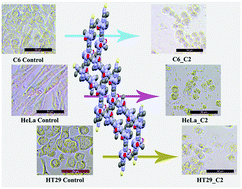Synthesis and characterization of two novel dicyanidoargentate(i) complexes containing N-(2-hydroxyethyl)ethylenediamine exhibiting significant biological activity†
Abstract
Two novel cyanido-bridged bimetallic polymeric complexes, [Ni(hydeten)2Ag(CN)2] [Ag(CN)2]·H2O (C1) and [Cd2(hydeten)2Ag4(CN)8]·H2O (C2) (hydeten: N-(2-hydroxyethyl)ethylenediamine) were synthesized and characterized by elemental, FT-IR, X-ray (C2), thermal and variable temperature magnetic measurement (C1) techniques. Their anticancer, antibacterial and antifungal effects were also investigated. The crystallographic analyses showed that C2 crystallizes in the monoclinic space group P21/c and shows a 3D 6,4 ladder-type polymeric chain in which the CdII centers are linked by [Ag(CN)2]− units. The Ag⋯Ag distance exhibits a short value of 3.1365(9) Å. It features a rare linear pentameric unit of [Ag(CN)2]− ions assembled via d10–d10 interaction as building blocks. Both complexes exhibited outstanding antibacterial, antifungal and anticancer activities against ten different bacterial strains, two plant pathogenic fungi (Alternaria solani and Rhizoctonia solani) and four tumor cell lines (HT-29, HeLa, C6 and Vero), respectively.


 Please wait while we load your content...
Please wait while we load your content...